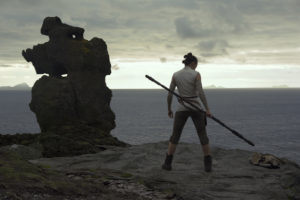
When Lucasfilm president, Kathleen Kennedy enlisted director Rian Johnson to write and direct Episode VIII in the Star Wars nine-film franchise, Johnson merely had three smaller-scale critical successes behind him as both writer and director: Brick, The Brothers Bloom, and Looper. However, for part eight in the nonology, Kennedy knew she needed an adept visual storyteller with demonstrable writing ability. Eventually, Johnson’s major tasks for what became known as Star Wars: The Last Jedi included a continuation of the arcs of the series’ new characters, including Rey, Finn, Poe Dameron, BB-8, Admiral Ackbar, Kylo Ren, General Hux, Maz Kanata, and Snoke, along with familiar characters, such as Luke Skywalker, Leia Organa, Chewbacca, Yoda, C-3PO, and R2D2.
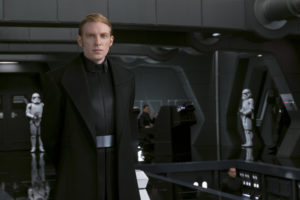
“The very first thing I did was read the script for The Force Awakens,” Johnson recalled of Episode VII, noting he then immersed himself in formulating the script for Episode VIII. “It had to feel right for the characters based on Force Awakens, and, secondly, it had to feel like a Star Wars movie, which has a lot to do with my sensibilities.”
As to whether Lucasfilm mandated that Johnson follow specific storylines in his screenplay, Johnson denied any specific interference in his initial creative process. “There wasn’t a big outline on the wall we had to follow,” he said. “I had to continue the story from The Force Awakens—that pointed in a big direction… stay true.”
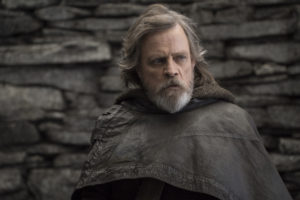
For Johnson, the total screenwriting process was about six months of effort. “For me, that’s really fast,” he quipped, adding that he sought assistance during this period. “I moved up to San Francisco and would go in twice a week to meet with a group of folks at Lucasfilm: a story group, creative execs. I would dump all of my ideas on the table and talk them through each step of the story. I never had that experience before; it helped me feel not so alone and scared.”
Of this fertile juncture in the process of realizing Episode VIII, Johnson described it as “a big creative conversation. It was getting to check in with a group of people you trust,” he related. “Everyone at Lucasfilm and Disney, especially Kathy Kennedy, were aware that each one of these movies needs to be personal for the filmmaker. They come from a single voice, George Lucas. Write from that—make it idiosyncratic and from my perspective. Otherwise, they’ll just be big machines; that’s not what the original films were—they were expressions of an individual. It’s just figuring out story, story, story.”
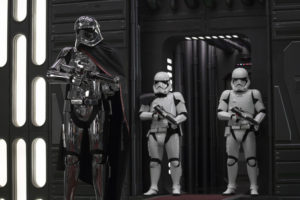
After his six-month screenwriting stretch concluded, Johnson entered a yearlong intensive cinematic preparatory period. “That’s where the movie is made,” he confessed. “Storyboarding, design for the new elements—designing sets, costumes—and you are designing all of that around shot design, previz for the action stuff. You are sick of sitting in rooms talking about it—you want to go shoot it. Your job as a director is to not get distracted by cool stuff and focus on the needs of the story in every single scene, every single shot.”
As with any effects-heavy project, Star Wars: The Last Jedi was meticulously previsualized. “We previz all the scenes that need it—the action scenes,” Johnson noted. “Based on that, we plan out the live-action elements: cockpits, blue screen scenes, and battles, to get the backgrounds. Then you get it in the edit room, you put the sequences together: chopping it down, rearranging it. You continue shooting previz through post-production.”
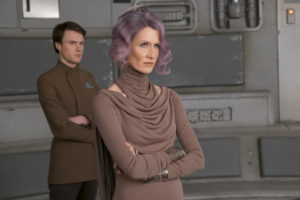
Of his 12 months working with Lucasfilm’s top artists, designers, and craftspeople, Johnson was decidedly appreciative. “Some of the most talented people in the world realize these concepts for you,” he described. “Beyond what you ever could have imagined. That process was my most joyous time of the last four years.”
When Johnson finally arrived on the set of a Star Wars film that he originally conceived, he had mixed emotions. “It felt really good to get on set, but it was scary,” he remembered. “Even if you’ve made movies before you think, ‘Do I know how to do this?’”
Fortunately, Johnson soon fell into a comfort zone given the people involved. “The actors are so great, and there was a good vibe on set,” he revealed. “The DP and I, Steve Yedlin, have been friends since we were 17-years-old… telling a story with a camera and some actors.”
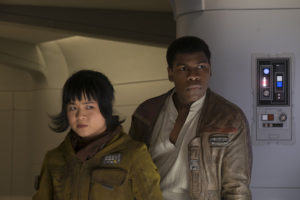
Once he embarked on shooting The Last Jedi, Johnson submerged himself into six months of work, including 110 days of shooting. Most of principal photography occurred at Pinewood Studios in London with several exotic locations, including a major location on the west coast of Ireland. “A local Irish crew built sets on the sides of hilltops,” Johnson conveyed. “We also got a couple of days, for key scenes, on the actual island, very remote, that Luke’s on—Christian monks lived there hundreds of years ago. We went to Dubrovnik, a city in Croatia, in Iceland, and a little bit in Bolivia.”
During principal photography, editor Bob Ducsay and a large post-production team toiled at Pinewood Studios, assembling the basic structure of the film and preparing shots for Industrial Light and Magic for their visual effects additions. “You turn over the type of stuff where you’re 80% certain this shot will be in the movie,” offered Johnson, noting that he began handing off shots to ILM while he was still shooting. “They feed you back at least early versions of shots as you are still editing the whole thing. It was about a year of post, including mixing and effects. We were editing right up until the very end.”
Throughout the post-production process, various stages of some 2000 effects shots were coming back to Johnson and Ducsay. “Very few shots in the whole film had nothing done to them,” Johnson said. “Ben Morris was our visual effects supervisor out of ILM in London. You have to coordinate with multiple facilities: ILM has effects facilities in San Francisco, London, Vancouver, Singapore, plus independent houses. A worldwide effort.”
After Johnson went back to Pinewood to get pickups, mostly reaction shots, he had everything in the can. Post-production finally wrapped in mid-autumn of 2017. Ultimately, Johnson was pleased with the results of his first epic-scale film. “I’m able to disconnect and appreciate all of the amazing work that went into it, and I’m really proud of what this whole team accomplished and where it takes the characters. Weirdly, you can never anticipate what any big experience like this is going to be, but it was the experience of my dreams. Not just Star Wars, but getting to make something on this scale that I genuinely believe in and is as meaningful or personal to me that I can imagine making. It was pretty special.”





